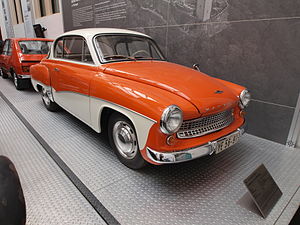 The Wartburg 311. During the 1950s and 1960s, over 1.8 million automobiles of the East German brand Wartburg were produced in the country | |
| Currency | East German mark |
|---|---|
| 1 January – 31 December (calendar year)[1] | |
Trade organisations | Comecon and others.[1] |
| Statistics | |
| GDP | $160 billion (1989) (Nominal GNP; 17th)[1][2] |
GDP per capita | $9,679 (1989) (Nominal GNP; 26th)[1][2] (official exchange rate) |
GDP by sector | 90% in industry and other non-agricultural sectors; 10% of GNP in agriculture (1987)[1] |
| 0.185 (1990) | |
Labour force | 8,960,000 (1987)[1] |
Labour force by occupation | 37.5% industry, 21.1% services, 10.8% agriculture and forestry, 10.3% commerce, 7.4% transport and communications, 6.6% construction, 3.1% handicrafts, 3.2% other (1987)[1] |
Main industries | Motor vehicles, Heavy industry, Electronics, Steel, Light industry, Defense |
| External | |
| Exports | $30.7 billion (1988)[1] |
Export goods | Machinery, transport equipment, fuel, metals, consumer goods, chemical products, building materials, semi manufactured goods and processed foodstuffs (1988)[1] |
Main export partners | USSR, Czechoslovakia, Poland, West Germany, Hungary, Bulgaria, Switzerland, Romania (1988)[1] |
| Imports | $31.0 billion (1988)[1] |
Import goods | Fuels, metals, machinery, transport equipment, chemical products and building materials (1988)[1] |
Main import partners | CMEA countries 65%, non-Communist countries 33%, other 2% (1988)[1] |
Gross external debt | $20.6 billion (1989)[1] |
| Public finances | |
| Revenues | $123.5 billion (1986)[1] |
| Expenses | $123.2 billion, including capital expenditures of $33 billion (1986)[1] |
| Economic aid | $4.0 billion extended bilaterally to non-Communist and less developed countries (1956-1988)[1] |
All values, unless otherwise stated, are in US dollars. | |

The economy of the German Democratic Republic (East Germany; GDR, DDR) was a command economy following the model of the Soviet Union based on the principles of Marxism-Leninism. Sharing many characteristics with fellow COMECON member states — the East German economy stood in stark contrast to the market and mixed economies of Western Europe and West Germany. The state established production targets, set prices, and also allocated resources, codifying these decisions in comprehensive plans. The means of production were almost entirely state-owned. The GDR had an above-average standard of living compared to other Eastern Bloc countries or the Soviet Union, and enjoyed favorable duty and tariff terms with the West German market; in 1989, it was estimated that 50 to 60% of its trade was with Western countries. However by the mid-1980s its economy had reached a state of stagnation,[3] contributing to the process of German reunification.